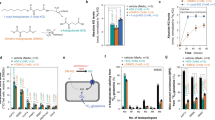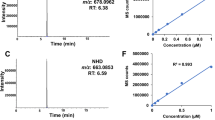Abstract
Coenzyme Q (Q) is an electron transporter in the respiratory chain and a lipid-soluble antioxidant that decreases in humans with age. Here we show that 4-nitrobenzoate inhibited 4-hydroxybenzoate:polyprenyl transferase (Coq2) in a competitive manner and dose-dependently decreased Q in mammalian cells without accumulation of Q intermediates. As 4-nitrobenzoate neither interfered with mitochondrial respiration nor induced oxidative stress, it should prove a valuable tool for studies on both Q deficiency and Q supplementation.
This is a preview of subscription content, access via your institution
Access options
Subscribe to this journal
Receive 12 print issues and online access
$259.00 per year
only $21.58 per issue
Buy this article
- Purchase on Springer Link
- Instant access to full article PDF
Prices may be subject to local taxes which are calculated during checkout


Similar content being viewed by others
References
Lenaz, G., Fato, R., Formiggini, G. & Genova, M.L. Mitochondrion 7, S8–S33 (2007).
Echtay, K.S., Winkler, E. & Klingenberg, M. Nature 408, 609–613 (2000).
Fontaine, E., Ichas, F. & Bernardi, P. J. Biol. Chem. 273, 25734–25740 (1998).
Papucci, L. et al. J. Biol. Chem. 278, 28220–28228 (2003).
Dallner, G. & Sindelar, P.J. Free Radic. Biol. Med. 29, 285–294 (2000).
Sohal, R.S. Methods Enzymol. 378, 146–151 (2004).
Sun, I.L. et al. Proc. Natl. Acad. Sci. USA 89, 11126–11130 (1992).
Martín, S.F., Navarro, F., Forthoffer, N., Navas, P. & Villalba, J.M. J. Bioenerg. Biomembr. 33, 143–153 (2001).
Villalba, J.M. et al. Proc. Natl. Acad. Sci. USA 92, 4887–4891 (1995).
Kalén, A., Appelkvist, E.L. & Dallner, G. Lipids 24, 579–584 (1989).
Kamzalov, S. & Sohal, R.S. Exp. Gerontol. 39, 1199–1205 (2004).
Galpern, W.R. & Cudkowicz, M.E. Mitochondrion 7, S146–S153 (2007).
Singh, U., Devaraj, S. & Jialal, I. Nutr. Rev. 65, 286–293 (2007).
Quinzii, C.M. et al. FASEB J. 22, 1874–1885 (2008).
DiMauro, S., Quinzii, C.M. & Hirano, M. J. Clin. Invest. 117, 587–589 (2007).
Rötig, A., Mollet, J., Rio, M. & Munnich, A. Mitochondrion 7, S112–S121 (2007).
Tran, U.C. & Clarke, C.F. Mitochondrion 7, S62–S71 (2007).
Nambudiri, A.M.D., Brockman, D., Alam, S.S. & Rudney, H. Biochem. Biophys. Res. Commun. 76, 282–288 (1977).
Alam, S.S., Nambudiri, A.M. & Rudney, H. Arch. Biochem. Biophys. 171, 183–190 (1975).
Clarke, C.F. Protoplasma 213, 134–147 (2000).
Miyadera, H. et al. J. Biol. Chem. 276, 7713–7716 (2001).
Duncan, A.J. et al. Am. J. Hum. Genet. 84, 558–566 (2009).
Acknowledgements
We thank T. Chojnacki (Institute of Biochemistry and Biophysics, Polish Academy of Sciences) for kindly providing the various radioactive and non-radioactive isoprenoids. We are also indebted to J.W. DePierre and B.D. Nelson (Department of Biochemistry and Biophysics, Stockholm Univ.) for valuable discussions during preparation of the manuscript. This work was supported by the Loo and Hans Osterman Foundation for Geriatric Research, the Ollie and Elof Ericsson Foundation, the O.E. and Edla Johansson Foundation, the Helge Ax:son Johnson foundation and the Carl Trygger Foundation.
Author information
Authors and Affiliations
Contributions
U.F., M.S. and M.T. performed the experiments. U.F. and P.J.S. designed the experiments, interpreted the data and wrote the manuscript. P.J.S. conceived the project.
Corresponding author
Ethics declarations
Competing interests
The authors declare no competing financial interests.
Supplementary information
Supplementary Text and Figures
Supplementary Figures 1–7, Supplementary Tables 1–3 and Supplementary Methods (PDF 931 kb)
Rights and permissions
About this article
Cite this article
Forsman, U., Sjöberg, M., Turunen, M. et al. 4-Nitrobenzoate inhibits coenzyme Q biosynthesis in mammalian cell cultures. Nat Chem Biol 6, 515–517 (2010). https://doi.org/10.1038/nchembio.372
Received:
Accepted:
Published:
Issue Date:
DOI: https://doi.org/10.1038/nchembio.372
This article is cited by
-
Small-molecule inhibition of the archetypal UbiB protein COQ8
Nature Chemical Biology (2023)
-
Quantitative shotgun proteome analysis by direct infusion
Nature Methods (2020)
-
Vitamin K2 cannot substitute Coenzyme Q10 as electron carrier in the mitochondrial respiratory chain of mammalian cells
Scientific Reports (2019)
-
Enhanced production techniques, properties and uses of coenzyme Q10
Biotechnology Letters (2014)



